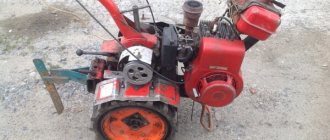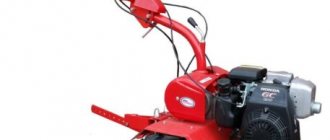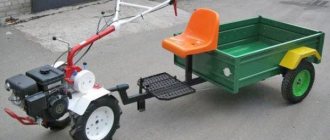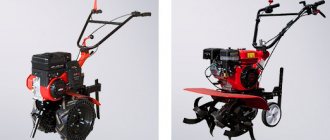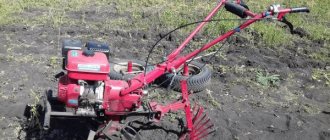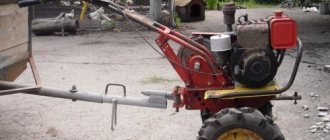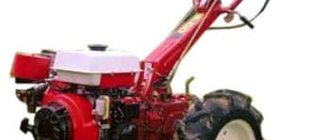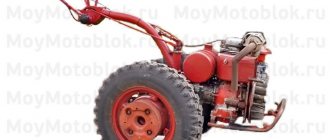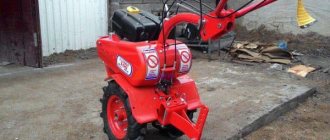PREPARING THE MOTOR FOR WORK
Preparation of the fuel mixture
The engine runs on a mixture of motor gasoline and oil M-8B, (M-8A) GOST 30541-78. During the running-in period of the engine, the oil content in the mixture should be about 8% (by volume), that is, 0.8 liters of oil per 10 liters of gasoline, and during operation - about 4% (by volume), that is, 0.4 liters of oil for 10 liters of gasoline.
Mixing oil with gasoline must be done thoroughly in a separate clean container until the oil is completely dissolved in gasoline. Fuel should be poured into the tank through a funnel with a fine mesh.
Operating the engine with insufficient oil content in gasoline is completely unacceptable, as it leads to engine failure. An increased oil content in the mixture makes it difficult to start the engine due to oiling of the spark plug electrodes, impairs the performance of the carburetor, leads to the formation of significant carbon deposits and increases pollution of the aquatic environment.
When using MS-20 oil during the running-in period of the engine, the oil content in the mixture should be about 6% (by volume), that is, 0.6 liters of oil per 10 liters of gasoline, and during operation - 3% (by volume), that is 0.3 liters of oil per 10 liters of gasoline.
Installing a motor on a boat
The motor is installed on a boat with a transom height of up to 384 mm.
To install the motor on a boat, you need to place it on the transom of the boat with clamps to the full depth of their grooves and tighten the screws.
The upper part of the gearbox housing must be at a depth of at least 30 mm.
If the transom is high and it is impossible to make a cutout in it, then it is necessary to attach the motor to an additional frame.
To reduce propeller cavitation, it is recommended to install the upper part of the gearbox housing (anti-cavitation plate) deeper than the lower part of the transom by 30-60 mm.
During operation, the tightness of the screws should be checked. To make it easier to control the boat, it is recommended to install the motor as close to the middle of the transom as possible.
When installing the motor, it is necessary to ensure the horizontal position of the propeller axis (taking into account the position of the boat when moving) by rearranging the roller in the holes of the clamp.
Starting the engine
The engine is started in the following order:
1. Unscrew the fuel tank cap screw 4-5 turns.
2. Open the fuel tap.
3. Fill the carburetor float chamber with fuel by pressing the float reducer 19 (Fig. 3).
4. Set the tiller handle to the low throttle position (turn clockwise).
5. Make 2-3 jerks with the starting rope. First, smoothly engage the stop with the flywheel, then jerk sharply. You should not pull the rope to the very end and throw it after launching.
After the engine has started, check whether water flows out and let it run at low gas for 3 minutes.
If the engine does not start, you need to check the condition of the spark plugs.
6. If starting is difficult, it is recommended to warm up the engine without immersing it in water, but no more than 15 seconds.
Stopping the motor
To stop the engine, you need to reduce the engine speed to minimum, and then turn off the ignition by pressing the engine stop button. In this case, fuel remains in the carburetor and pipe, which must be drained when removing the engine from the boat.
In cases where the engine is turned off for a long time, it is recommended to stop it by running out of fuel in the pipe and carburetor. To do this, you need to turn off the fuel valve. After the carburetor runs out of fuel, the engine stalls.
Running in the engine
The new motor cannot be operated immediately at full load. Running in is necessary to break in parts.
The running-in period should be 10-12 hours, which corresponds to the time the first 6-8 tanks of fuel are used up.
During engine break-in, it is necessary to operate at lower speeds.
After the first two tanks of fuel have been used up, you need to check and clean the spark plug electrodes, tighten all screws and nuts, including the flywheel nuts, and tighten them if necessary.
After break-in, the oil in the gearbox should be changed.
Description
The production of various fifth modifications began in the nineties, and since then, Salyut walk-behind tractors have confidently taken second place after the Neva in demand.
A well-thought-out solution from aircraft designers, high reliability of the transmission in combination with a professional Briggs&Stratton engine make the Salyut 5BS-1 durable and unpretentious. A variety of attachments multifacetedly expands the functionality of the walk-behind tractor, turning it into a universal machine.
Despite its heavy weight, the walk-behind tractor can be transported in the trunk of a car. Removing the wheels and steering wheel is easy. Some similar models of walk-behind tractors cannot boast of this.
Engine
Engine of the new generation Briggs & Stratton (US brand) Vanguard, model 13N3, 6.5 hp.
Engine Briggs&Stratton 13Н3
Vanguard series engines are assembled in Japan (Mitsubishi). The engine features an exceptionally high degree of assembly precision.
Oil SAE10W40
The engine operating manual emphasizes the need to change the oil after the first 5-8 hours of engine operation, which is the break-in cycle of the Salyut 5BS-1 walk-behind tractor.
Recommended oil SAE10W40 or SAE30 (at low temperatures).
Vanguard Engine Benefits
- top placement of valves;
- providing double protection thanks to Dual-Clean - automotive-style air filter;
- the presence of a fuel tank cap helps reduce the emission of gasoline vapors;
- Thanks to the Lo-Tone muffler, reduced noise levels are ensured;
- possibility of adjusting the rotation speed;
- thanks to the float carburetor, starting is carried out with one movement of the starter handle;
- not demanding on fuel quality - unleaded (leaded) gasoline with an octane number of more than 85 is recommended;
- Magnetron electric start and a special Super Lo-Tone muffler can be optionally installed.
Transmission
Gearbox
The clutch is a belt clutch with two belts. The gear reducer is the main feature of the walk-behind tractor. It is able to withstand any load, especially from impacts during plowing (stones, other foreign objects). Typically, such powerful gearboxes are installed on heavy equipment.
Main parameters:
- for ease of use, it has 2 speeds - forward and reverse;
- the steering column can be adjusted in two planes - horizontally and vertically;
- a decrease in speed can be obtained by rearranging the belts;
- reverse speed is engaged on the gearbox;
SHOM
Pulley
The walk-behind tractor has a power take-off pulley (PTO) for working with active drive implements. The shaft located on the right side of the gearbox can be used for mounting stationary equipment.
Frame
The walk-behind tractor frame is a structure on which, in addition to the engine and gearbox, protective wings, a support, and a steering column are installed. The walk-behind tractor has excellent stability against tipping due to the shifted center of gravity to the front of the structure. There is no provision for pin installation.
Equipment
When purchasing a walk-behind tractor, the kit includes:
- 4 cutters, 6 more can be purchased as an option. The rotation speed when plowing the soil can vary between 20-130 rpm, cultivation width 350-800 mm.
- Pneumatic wheels. They are used when transporting cargo, a walk-behind tractor. If it is necessary to attach certain types of units, the track width can be increased by using expansion bushings and wheels of larger diameter.
- Hitch bracket. Installed in the rear part of the walk-behind tractor, it is intended for attaching trailed units directly to the bracket or using a universal hitch.
- Opener. This is a limiting device for regulating the depth of tillage depending on the quality of the soil, the maximum depth is 250 mm.
Characteristics
| Engine: | Briggs&Stratton Vanguard 6.5 |
| Number of speeds: | 1 forward/1 back |
| Plowing width: | 80/60/35 cm (6/4/2 cutters) |
| Plowing depth: | 25 cm |
| Clutch: | V-belt drive with tension roller |
| Gearbox: | mechanical, gear |
| Gearbox oil volume: | 1.1 l |
| Equipment: | Walk-behind tractor, 4 cutters for loosening the soil, pneumatic wheels, coulter |
| Engine's type: | gasoline, carburetor, 4-stroke |
| Cylinder volume: | 205 cc cm |
| Fuel tank capacity: | 4.1 l |
| Oil volume: | 0.6 l |
| Chassis system: | Single-axle, 2x2 wheel arrangement |
| Ground clearance: | 11…12 cm |
| Wheel size: | 39…41 cm (pneumatic) |
| Track: | Variable step adjustable |
| Track width: | Normal-260 mm; with extensions - 540 mm |
| Turning Radius: | 1.5 m |
| Dimensions: | 1510x620x1335 mm, no more, in working position |
| Weight: | 62…82 kg according to instructions |
| Manufacturer country: | Russia |
| Guarantee: | 1 year |
Maintenance of Oka
Maintenance of a walk-behind tractor includes several stages:
- Daily work before and after use.
- Change of oil.
- Scheduled inspection.
- Preservation for long-term storage.
Let's consider the first point.
Before operating the Oka walk-behind tractor, you must:
- check the oil and fuel levels; only fill in high-quality working fluids;
- check the reliability of bolted connections;
- check tire pressure.
After use you must:
- thoroughly clean and wash the walk-behind tractor;
- dry in the shade;
- lubricate all components and mechanisms;
- put into storage.
Motoblock Oka with plow
No less important is the second point - “Oil change”. The first replacement is made after running in the walk-behind tractor. After every 25 operating hours, the oil level in the gearbox is checked and fluid is added if necessary. The transmission oil is changed every 50 operating hours.
Routine inspections must be carried out after the first 100, 200 and 500 engine hours; it is recommended to completely change the oils, both in the engine crankcase, gearbox, and transmission.
It is recommended to fill the engine of the Oka walk-behind tractor with the following motor oils:
- M-53/10G1;
- M-63/12G1.
We invite you to watch a short video showing how to change the oil in the gearbox of an Oka walk-behind tractor:
Malfunctions
The instructions included with the Oka walk-behind tractor contain a table that lists all possible problems, but we will focus on the most common ones:
Why the Oka walk-behind tractor does not start:
- the tank has run out of fuel;
- the oil level in the crankcase is below normal;
- the ignition system of the Oka walk-behind tractor requires adjustment or has failed;
- carburetor adjustment required;
- filters are clogged and require replacement;
- spark plugs are burnt out, smoked or wet;
- the seals have failed.
The wheels (cutters) have stopped rotating:
- the clutch cable is loose;
- it is necessary to change stretched or torn belts, this will help restore the functionality of the Oka walk-behind tractor.
What to do if the speed jumps on the Oka walk-behind tractor and the gear shift does not work:
- it is necessary to inspect and, if necessary, repair the gearbox - replace broken sprockets, chains, bearings, seals;
- adjust the axle axle release mechanism;
- check gear locking.
We invite you to watch a video on how to change the bearing and replace the oil seal on the gearbox of an Oka walk-behind tractor:
Installing belts on the Oka walk-behind tractor
In order to perform the replacement, it is necessary to determine what size drive belt is required for the Oka walk-behind tractor. The following drive belts are available for sale:
For reverse:
- Z(0) 1400 I;
- Z(0) 1400 ext I GOST 1284.1-89.
The belt is dismantled manually by loosening the adjusting bolt. The new belt should not sag, nor should it be under strong tension. Correct tension is when the belt bends slightly when pressed with your hand.
Lighting for Oka walk-behind tractor
Many owners of this equipment strive to modernize the device as much as possible, to further increase comfort and ergonomics when working. One of the ways to modernize is to install lights (headlights).
Making light on an Oka walk-behind tractor is not that difficult; you just need to find and connect a generator of the required power to the unit. The connection algorithm is as follows:
- a button is placed on the steering wheel;
- the generator is attached to the walk-behind tractor;
- headlights are attached to the front of the motorized device;
- through wires, a connection is made from the button to the generator and to the headlight;
- wires are insulated.
The more powerful the generator, the brighter the light will be; many people prefer to install automobile electric generators on this agricultural equipment. We invite you to watch a video on how to install the light on the Oka walk-behind tractor yourself:
Owner reviews
Owners of Salyut-5 walk-behind tractors mostly speak only positively about it, but sometimes there are reviews online with slight criticism. As for the strengths, users most often note the efficiency, power, performance and versatility of the unit. The owners consider the weaknesses of the equipment to be its low weight with high engine power. Many people, in order to plow a plot of land with a cultivator, install additional loads on it.
Oleg:
Peter:
Pasha:
Elena:
Motoblock Salute Honda GC-190 is the company’s second most popular product
The unit is an excellent choice for those who have small garden plots and need a multifunctional assistant that can withstand considerable loads.
The main highlight of the walk-behind tractor is the Honda GC 190 engine. The design of this part consists of lightweight mechanical elements and reflects the latest developments of Japanese experts. As a result, the new product pleases with low fuel consumption, maximum environmental friendliness, noiselessness and a single-sided cylinder.
Model specifications:
- Power – 5.5 – 6.0 hp;
- Fuel tank capacity – 1.8 l;
- Clutch type – belt;
- Engine capacity – 33cm3;
- Type of gearbox – gear;
- Weight – 75 kg.
Thanks to the low center of gravity, operating and maintaining the walk-behind tractor becomes very convenient. The operating instructions presented on our website will help you solve many problems with functionality.
Modifications
Salyut-5 walk-behind tractors have 3 modifications, which differ in engine type:
- Salyut 5L-6.5 runs on a 4-stroke gasoline engine with a power of 6.5 hp. Such a universal unit can single-handedly replace an entire fleet of specialized equipment.
- The Salute 5-R-M1 is equipped with a Subaru 4-stroke gasoline engine. The design of the unit provides the ability to connect various equipment to solve various business problems.
- Salute 5BS-6.0 operates on an American 4-stroke gasoline engine with a cylinder displacement of 206 cm³ and powerful performance of 6.5 hp. A high-performance and reliable motor allows you to cultivate virgin areas and easily copes with the cultivation of difficult soils.
Advantages and disadvantages
The advantages of these units are as follows.
- The manufacturing company uses engines from well-known world manufacturers (Lifan, Subaru, Honda, Briggs&Stratton, Vanguard).
- Walk-behind tractors are equipped with durable gear reducers, which combine the reverse function, reliability and ease of operation.
- The V-belt drive has two belts. This ensures comfortable work due to less belt slippage.
- For forward movement there are 2 gears and 1 reverse gear.
- Convenient switching to a lower speed range.
- Due to the presence of a power take-off shaft, it is possible to connect trailers.
- Due to the moved center of gravity down and forward, the walk-behind tractors acquired excellent stability.
- Steering column that can be adjusted in two planes.
- Possibility of combining standardized attachments from different manufacturers.
- The simple design of the walk-behind tractor makes it easier to work with.
- Processing width up to 90 cm.
- Compact sizes.
- Quiet engine operation.
The technology also has its disadvantages.
- There are slight doubts about the Lifan engine. It is inferior in reliability to engines from Honda, Briggs & Stratton, Subaru, Vanguard, so it is worth choosing those units that have engines from these manufacturers.
- The design of the belt drive is quite reliable, but there are many reviews that talk about the mediocre quality of the belts; they have to be changed frequently.
- Increased fuel consumption.
Attachments
The Salyut 5 BS-1 walk-behind tractor, when combined with attachments, is capable of not only performing a variety of agricultural and household work, but also greatly facilitating human labor.
Thanks to the mechanization of processes, many jobs are completed quickly and efficiently. The compact shape and high maneuverability allow the walk-behind tractor to be used in places with limited space - in greenhouses, vineyards.
Additional attachments can be mounted on the walk-behind tractor in different ways (in accordance with its characteristics and equipment):
- using a universal hitch;
- through the power take-off shaft;
- on the gearbox axis.
Using a trailer hitch via a universal hitch or directly
Trailer Potato planter Reversible plow Blade
Devices with active drive via power take-off shaft
Pump Snow blower Rotary mower Broom
On the gearbox axis
Milling cutters Grousers Weighting weights Weeder
Motoblocks Salyut 5: a series of noteworthy models
The above-discussed device options are distinguished by their originality and the highest level of popularity. Representatives of the Salyut 5 series are somewhat inferior to them in terms of prevalence, but not at all in functionality. Before considering the specifics of each object, you should familiarize yourself with the general advantages of all representatives of the group.
- Multifunctionality;
- Significant width of the cutting elements of the cutters;
- Compactness and relative lightness;
- Adjustable steering wheel;
- Solid rubberized wheels;
- Ability to control the transmission and gearbox via the steering wheel;
- Reduced vibration levels through handles;
- The presence of 2 belts that increase the power of the unit;
- Equipped with a free pulley.
Long-term operation of machines by satisfied owners is clear evidence that these positive qualities correspond to reality.
Owner reviews
Doctor Mikhail, Kazyatyn:
“If you modernize the Salyut 5 walk-behind tractor and move the gear shift knob closer to you, on the steering column, it will be much more convenient to work. A special kit for shifting gears specifically for Salyut has been sold for a long time. The necessary attachment, additional cutters, electric ignition can also be purchased separately, and Salyut 5 BS-1 will be no different from Salyut-100.”
Sotnik Nikolay, Poltava region:
“I tilled the soil with Salute 5 Briggs & Stratton, first mowed the grass with a walk-behind mower, then collected it with a rake, went through it twice with cutters, then made the beds with a plow, everything was fine. I tried to work with horse harrows, but the MB hardly pulls, it gets buried. Can heavy harrows for its weight. I'm thinking of thinning out the teeth. And so it cultivates normally. Well, if it’s virgin soil, then you still need to clear the grass from the shaft and take breaks.”
Features of SKAT-1200A
- supplying the load with a constant stabilized voltage according to clause 2 of the table in the presence of voltage in the electrical network;
- optimal charge of the battery (hereinafter referred to as battery) in the presence of mains voltage ("MAIN" mode);
- automatic transition to backup power from the built-in battery (“RESERVE” mode) when the electrical network is disconnected;
- backup power supply of the load with constant voltage according to clause 2 of the table;
- protection against reverse polarity of battery terminals (self-restoring fuse);
- maintaining operability in the event of a break or short circuit in the battery circuit (if there is supply voltage);
- automatic protection (output shutdown for 1 minute) against short circuit or increase in output current above the maximum value (see table, clause 4);
- automatic restoration of operability (nominal parameters) after eliminating the causes of an increase in the output current above the maximum value or short circuit;
- light indication ("NETWORK" indicator) of the presence of mains voltage ("MAIN" mode);
- light indication ("Battery" indicator) of the presence (within normal limits) of a serviceable and charged battery;
- light indication ("OUTPUT" indicator) of the presence of output voltage ("OUTPUT" indicator);
- light alarm (battery indicator blinks once per second) indicating the imminent shutdown of the output voltage due to battery discharge;
- light signaling (short-term switching on of the battery indicator once every 4 seconds) about turning off the output voltage in the “RESERVE” mode due to the battery being discharged;
- battery protection in case of short circuit in the load;
- battery protection from deep discharge;
- automatic generation and transmission to external circuits of an information signal in the open collector (“OK”) format: about the absence of network voltage “TRANSFER TO RESERVE”;
- “cold start” function: restoring the source’s functionality when connecting a working and charged battery in the absence of mains voltage;
- time of technical readiness for work is no more than 20 seconds. after connecting to a mains voltage source or battery;
- maintaining operability both during and after exposure to elevated and/or reduced ambient temperatures, increased relative humidity and increased sinusoidal vibration.
